FREE Uber Tax Info Pack
FREE 5-Day Email Course to learn the ATO’s Uber tax rules
FREE Uber Expense Spreadsheet so you never miss a deduction
FREE Uber Logbook Spreadsheet to claim your car expenses
FREE ABN & GST Registration (if you need it!)
FREE Uber Tax Info Pack
> FREE 5-Day ‘Uber Tax Essentials’ eCourse
> FREE Uber Bookkeeping Spreadsheet
> FREE Uber Logbook Spreadsheet
> FREE ABN & GST Registration
Uber Tax Explained – The Ultimate Guide to Tax for Uber Drivers
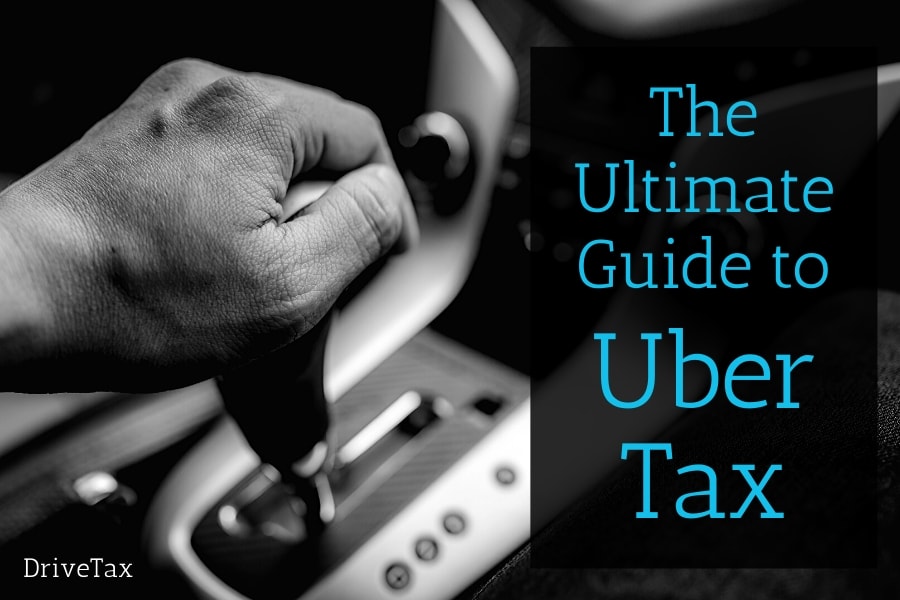
Updated 28th of June 2024
Uber taxes are one of the biggest worries for drivers in Australia.
Most drivers I chat to say that dealing with the ATO and their tax obligations for Uber is stressful. It’s also a big hesitation for people thinking about starting with Uber in the first place.
Of course no-one loves paying tax, but we understand that it’s a necessary part of life. Taxes pay for our roads, schools, hospitals and all the other public services we need. So it’s inevitable that rideshare drivers, like everyone in Australia, have to pay tax on their income.
But what makes taxes for Uber and rideshare drivers difficult is that the ATO’s Uber tax rules are complicated. For most drivers, it’s their first time dealing with GST, BAS’s and logbooks, so there’s a big learning curve. The problem is there’s alot of bad tax advice and false information online, and many accountants and tax professionals don’t fully understand how Uber taxes work. So it’s hard to know who to trust.
It’s important to manage your Uber taxes the right way from the start. If you don’t keep records of your tax deductions correctly and save for your tax bill as you go, then it can become very stressful at tax time, and create a financial burden on you and your family.
So in this post, my goal is to explain in detail how Uber tax in Australia works, and how you can prepare for your Uber tax return in the best possible way so that the end of the financial year is simple and stress-free.
A quick note for UberEats and Food Delivery Drivers: most of the information in this post (besides the GST parts) applies to you also. But I’ve also written a specific post on Tax for UberEats and Food Delivery Drivers, so be sure to check that out as well.
Table of Contents
1) Introduction to Tax for Uber Drivers
1.1) Do Uber Drivers Have To Pay Tax?
1.2) Do Uber Drivers Have to Pay GST?
2) Registering with the ATO
2.1) Getting an ABN for Uber
2.2) Getting Registered for GST for Uber
3) GST for Uber Drivers
3.1) How GST On Uber Income Is Calculated
3.2) BAS’s For Uber Drivers
4) Income Tax for Uber
4.1) How Much Tax Will I Pay On My Uber Income?
4.2) How Is Tax On Uber Income Calculated?
4.3) Do I Have To Pay Tax On Uber Tips?
4.4) What Uber Tax Deductions Can I Claim?
4.5) How Do You Keep A Logbook For Uber?
4.6) What Receipts Do You Have To Keep For Uber?
4.7) Saving For Your Uber Tax Bill As You Go
5) Tax Returns For Uber Drivers
5.1) What Is A Tax Return?
5.2) Tax Return Due Dates
5.3) How To Lodge Your Uber Tax Return With A Tax Agent
5.4) How To Lodge Your Uber Tax Return On MyGov Yourself
5.5) Paying Your Uber Tax Bill
5.6) Payment Arrangements
Skip To The Good Bits!
Looking for an accountant to lodge your Tax Return?
Jump here to read about DriveTax Express Tax service.
Looking for the DriveTax FREE Spreadsheet to help you lodge your own Tax Return?
Jump here for the free spreadsheet download.
Want to learn how to lodge your own Uber Tax Return on MyGov?
Jump here to read more about the Understanding Uber Taxes online course and MyGov video tutorials.
Introduction to Tax for Uber Drivers
There are two different kinds of tax that apply to Uber drivers, GST and Income Tax. Income Tax applies to everyone, while GST only applies to rideshare drivers. Let’s take a look in more detail.
Do Uber Drivers Have to Pay Tax?
Yes, Uber income is taxable, just like all income earned by employees, contractors and business in Australia. Every rideshare driver must calculate their rideshare income, subtract their tax deductions, and the remaining profit is taxable income which must be declared to the ATO.
The amount of tax you have to pay will depend on your marginal tax rate. Your marginal tax rate is based on your total taxable income from all sources, including Uber driving plus any other jobs you have. I’ll explain this in more detail below in the section called How Much Tax Will I Pay On My Uber Income?
Note that even if you are below the tax-free threshold and will not have any tax to pay on your Uber income, you MUST still lodge an income tax return. This is because there are different rules for ABN holders than for regular employee-only tax returns. If you earn more than $1 on your ABN, you must lodge a tax return, even if you are below the tax-free threshold.
Do Uber Drivers Have to Pay GST?
GST stands for Goods and Services Tax. It’s a tax of 10% on all the goods and services sold in Australia. I’ll explain a little more about how GST for Uber works below.
- Rideshare Drivers: ALL rideshare drivers must register for GST, thanks to special ATO tax laws for taxi and rideshare drivers. The usual $75,000 threshold does not apply.
- Food Delivery Drivers: If you only do food delivery, and you don’t do any rideshare driving, then you do not have to register for GST. The only exception is if your total ABN income (including from other sources of ABN income, but not employee income) is more than $75,000.
- Rideshare AND Food Delivery: If you do both ridesharing AND food delivery, then the rideshare rules apply and you must register for GST.
Once you register for GST, that GST registration applies to ALL business/sole-trader income you earn on your ABN. So if you also do work as a freelancer or independent contractor, or have other small business income, that income will now be subject to GST as well.
Registering with the ATO for Uber
If you’re a new rideshare driver, here are the two ATO registrations you will need before you begin driving.
Getting an ABN for Uber
ABN stands for Australian Business Number. Every rideshare and food delivery driver in Australia must have an ABN. You can register for an ABN on the ATO website yourself for free, or you can use DriveTax’s free ABN application service.
We only get one ABN for our whole lifetimes, and we must use this one ABN for all of our business activities. So if you already have an ABN or you have had one in the past then you must use this same ABN for Uber as well. If your past ABN is now cancelled or inactive, you will need to reactivate it to use as your Uber ABN. You can look up your current or past ABN on the Australian Business Register.
> Free ABN & GST Application as part of the DriveTax Free Uber Tax Info Pack
Getting Registered for GST for Uber
Your GST Registration is attached to your ABN. If you don’t already have an ABN, you can apply for your rideshare ABN and GST Registration both in the same application. Or if you already have an ABN you will add your GST registration to that existing ABN.
Rideshare drivers have the option to register for GST monthly or quarterly (annual GST registration is not permitted for rideshare drivers, see the ATO’s website here). I strongly recommend registering quarterly, as a monthly registration means three times as much work in lodging BAS’s. Our Uber Driver’s Guide to GST explains in more detail.
Again, it’s free register for GST yourself via the ATO website, or you can use the DriveTax Free GST Registration Service. We take care of your ATO application for you, including applying for a new ABN or reactivating an old one.
GST For Uber Drivers
I won’t go into too much detail on GST here because I’ve written a whole blog post just like this one called Uber BAS Explained – The Ultimate Guide to BAS’s for Uber Drivers. You can head there if you want more detail, but for now let me just give you the basics.
How GST on Uber Income Is Calculated
All GST-registered businesses in Australia, including all rideshare drivers, must pay GST of 1/11th on their business income to the ATO. For Uber drivers, this means 1/11th of the Gross Fares, Split Fare Fees, Booking Fees, Tips, and all other amounts that you receive from the passenger.
You can claim back any GST you pay as part of your business related expenses. This includes the GST that Uber charges you on their Service Fee, and the GST on all the other parts of the fare you pass on to Uber, like the Split Fare Fees and Booking Fees. It also includes expenses you pay for yourself, such as fuel, mints, stationery, and your mobile phone bill (although some of these need to be apportioned for your business vs private use percentage).
BAS’s for Uber Drivers
A Business Activity Statement (BAS) is an ATO form used to declare your income/sales and the amount of GST payable on those sales (1/11th). You’ll also declare your business expenses and the GST claimable on those expenses. Your GST on Sales minus your GST on Expenses equals your Net GST Payable/Refundable.
Most Uber drivers are registered for GST quarterly, which means they must lodge a BAS and pay GST every three months. There are three ways you can lodge your Uber BAS. You can lodge yourself via MyGov, lodge yourself via paper form, or lodge through a tax agent such as DriveTax. The due date of your BAS depends on which lodgement method you choose:
| Q1 – September Quarter | Q3 – March Quarter |
| 1st July – 30th September | 1st January – 31st March |
| • Lodge yourself – paper form – 28th October | • Lodge yourself – paper form – 28th April |
| • Lodge yourself – MyGov – 11th November | • Lodge yourself – MyGov – 11th May |
| • Lodge with Tax Agent – 25th November | • Lodge with Tax Agent – 25th May |
| Q2 – December Quarter | Q4 – June Quarter |
| 1st October – 31st December | 1st April – 30th June |
| • Everyone – 28th February | • Lodge yourself – paper form – 28th July |
| • Lodge yourself – MyGov – 12th August | |
| • Lodge with Tax Agent – 25th August |
Q1 – September Quarter
1st July – 30th September
• Lodge yourself – paper form – 28th Oct
• Lodge yourself – MyGov – 11th Nov
• Lodge with Tax Agent – 25th Nov
Q2 – December Quarter
1st October – 31st December
• Everyone – 28th Feb
Q3 – March Quarter
1st January – 31st March
• Lodge yourself – paper form – 28th Apr
• Lodge yourself – MyGov – 11th May
• Lodge with Tax Agent – 25th May
Q4 – June Quarter
1st April – 30th June
• Lodge yourself – paper form – 25th July
• Lodge yourself – MyGov – 12th Aug
• Lodge with Tax Agent – 25th Aug
Again, if you want to learn more about Uber Business Activity Statements and GST, including how your BAS is calculated, what rideshare expenses you can claim on GST, and more detail about how to lodge your BAS, you’ll find it in our Ultimate Guide to Uber BAS’s.
> Lodge your BAS with DriveTax with our Express BAS service for Uber and Rideshare drivers.
Income Tax For Uber
In this next section I’ll break down how the ATO calculates your Uber taxable income and tax deductions. We’ll also cover what records and receipts you need to keep throughout the year to be prepared for tax time.
How Much Tax Will I Pay On My Uber Income?
The amount of tax you will pay on your Uber profits depends on your total taxable income, which includes income from other jobs and other sources. The ATO uses a ‘marginal tax rate’ system to calculate this.
| 2023 & 2024 Financial Years | |
| Taxable Income | Marginal Tax Rate * |
| $0 – $18,200 | 0% |
| $18,201 – $45,000 | 21% |
| $45,001 – $120,000 | 34.5% |
| $120,001 – $180,000 | 39% |
| $180,001 and above | 49% |
(* these rates include the Medicare Levy)
| 2025 Financial Year | |
| Taxable Income | Marginal Tax Rate * |
| $0 – $18,200 | 0% |
| $18,201 – $45,000 | 18% |
| $45,001 – $135,000 | 32% |
| $135,001 – $190,000 | 39% |
| $190,001 and above | 49% |
(* these rates include the Medicare Levy)
Here are some examples based on the 2025 financial year:
- If you earn $30,000 from your employee job and $5,000 of Uber profits, then your Uber profit will be taxed at 18%.
- If you earn $40,000 from your employee job and $10,000 of Uber profits, then $5,000 of your Uber profits will be taxed at 18% and the other $5,000 will be taxed at 32%
- If you don’t have an employee job or any other income, and you earn $15,000 of Uber profits, then your whole profit will be below the tax-free threshold, and your tax bill will be $0.
How is Tax on Uber Income Calculated?
As I mentioned earlier, all amounts that you receive from a passenger must be declared as income, and then all the amounts that you pass on to Uber can be claimed as an expense. Let’s take a look at this example of an Uber Monthly Tax Summary to show how the tax calculation works.
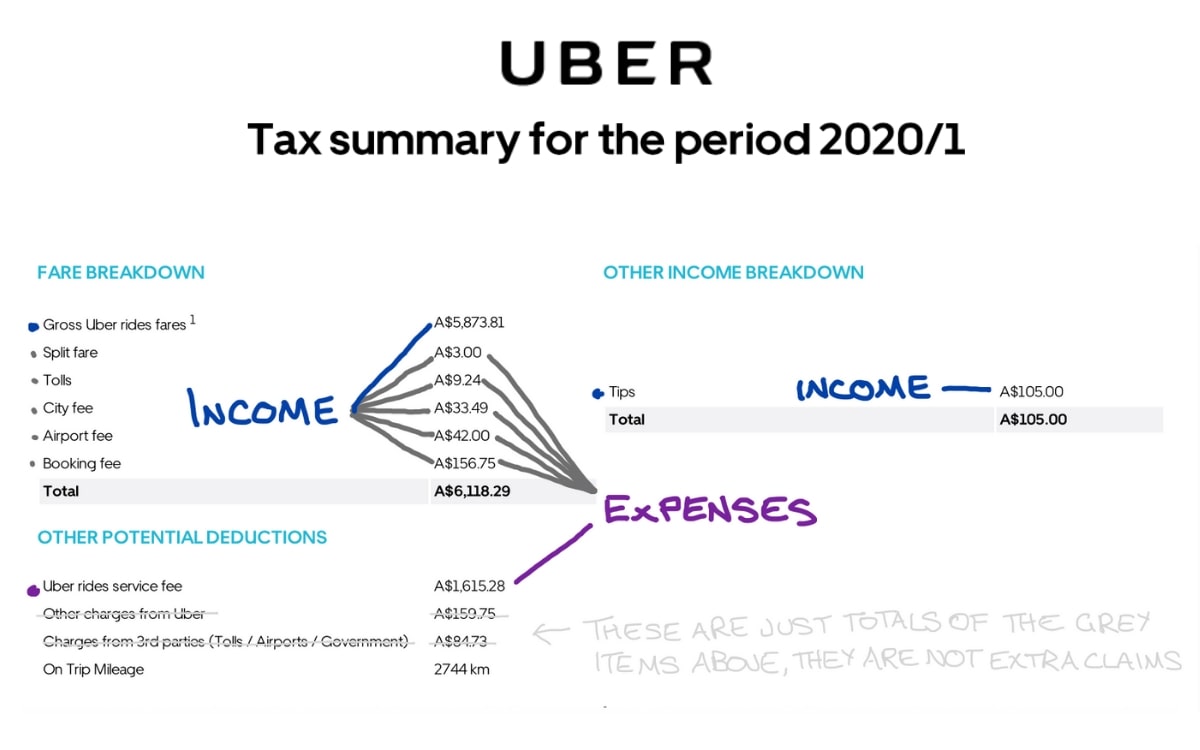
Grey Items: First, take a look at the items marked with grey above, Split Fare Fees, Tolls, City Fees, Airport Fees and Booking Fees.
You receive these amounts from your passenger as income, and then you pass them on to Uber as an expense, so from your perspective they cancel each other out. However, even though your net income from these items is $0, the ATO still requires you to show the two sides of the equation separately. So in the income section of your tax return business schedule you’ll declare them as income, and in the expenses section you’ll declare the same amounts as expenses. The two amounts cancel each other our, so rest assured that you’re not paying any tax on income that actually belongs to Uber, you will only pay tax on the amounts that end up in your pocket! The ATO just want you to show the two sides of the equation.
The remaining amounts, Gross Uber Fares, Tips, Incentives, and Uber Service Fees, are calculated as follows:
Income = Gross Uber Fares + Split Fare Fees + Tolls + City Fees + Airport Fees + Booking Fees + Tips + Incentives
Expenses = Uber Service Fees + Split Fare Fees + Tolls + City Fees + Airport Fees + Booking Fees
Taxable Profit = Income – Expenses
(Of course you will also claim all your car expenses, mobile phone and other Uber expenses, but in this example I just want to show this part of the calculation).
Do I Have To Pay Tax On Uber Tips & Incentives?
Yes, Uber tips are taxable. This is because the ATO’s fundamental rule for business taxes is that all income you earn in the course of running your business is taxable.
This means that any tips you receive from passengers, or incentives you receive from Uber, in the course of running your rideshare or delivery business are counted as taxable income, and must be declared in your tax return. You can find confirmation of this on the ATO’s ride-sourcing webpage.
What Uber Tax Deductions Can I Claim?
Maximising your tax deductions is the most important thing you can do to reduce your Uber tax bill. However, it’s important to remember that when an expense is tax-deductible, that doesn’t mean it’s free, or that you’re getting all the money back from the ATO. The amount you get back is based on your marginal tax rate.
For example, let’s say you spend $100 on car seat covers, you have a logbook of 80%, and your marginal tax rate is 18%:
- Tax deduction = $100 x your 80% logbook = $80
- Tax back = $80 tax deduction x your marginal tax rate of 18% = $14.40
As you can see, from your $100 purchase, you got $14.40 back from the ATO, so the remaining $85.60 came out of your pocket. You can think of your marginal tax rate like a discount on business purchases, so if your marginal tax rate is higher you get a bigger discount, or if you’re below the tax-free threshold then your discount is 0%.
Based on this, I always advise that saving on your taxes is a two-step process:
- Try to minimise your expenses as much as possible. Don’t spend money just for the sake of getting a tax deduction, because most of the cost still comes out of your pocket. If you can avoid the expenses, you will be financially better off.
- If you must spend the money, make sure you keep the correct records so you can claim a tax deduction, and at least get some of the cost back from the ATO.
Here’s a list of common tax deductions for Uber drivers. Note that for some that I’ve marked with (%) you will need to apportion your tax deduction for business use vs private use:
- Rideshare Fees & Charges
- Rideshare Company Service Fees
- Booking Fees
- Split Fare Fees
- Airport Fees
- Government fees
- Car Expenses (%) (logbook required, more on this below)
- Fuel or EV charging (see our article on Claiming an EV for Uber)
- Insurance
- Registration
- Repairs
- Servicing and Maintenance
- Tyres
- Cleaning
- Accessories
- Hire/Rental Fees
- Loan Interest (not the whole repayment)
- Depreciation (including the Instant Asset Write Off)
- Other Expenses
- Accountancy
- Bank Fees
- Computer Expenses
- Courses & Training
- Fees, Licences, Permits
- First Aid Kit
- Internet (%)
- Mobile Phone (%)
- Music Subscriptions (%)
- Parking (only during an active shift)
- Rider Amenities (mints, water, tissues etc)
- Sanitation & Hygiene (masks, sanitiser, wipes)
- Stationery
- Sunglasses
- Tolls
- These expenses are considered personal expenses or otherwise are not deductible
- Clothing
- Coffee
- Fines
- Food
- Parking at Home
- Personal Comfort
- Personal Hygiene
- Prescription Glasses (only sunglasses can be claimed)
> To learn more about claiming tax deductions download our free Uber Tax Info Pack
How Do You Keep A Logbook for Uber?
If you want to claim your fuel, insurance, depreciation and other car expenses, you MUST have a valid ATO logbook. The logbook is required by the ATO as evidence of the percentage of car expenses you can claim.
Without a logbook, you’ll be restricted to the ‘cents per kilometre method’ to claim your car deductions. This method allows you to claim a maximum of 5,000km at a set rate, so your total tax deduction is limited. Here are the rates:
- 2022-2023: the rate is 78 cents per km, so your maximum claim is 5,000km x 78c = $3,900
- 2023-2024: the rate is 85 cents per km, so your maximum claim is 5,000km x 85c = $4,250
- 2024-2025: the rate is 88 cents per km, so your maximum claim is 5,000km x 88c = $4,400
If you only drive a little, then this might be fine for you. And of course it’s much easier to use the cents per km method rather than keeping a logbook and keeping all your fuel receipts. But if you drive a lot, the cents per km method will give you a much smaller tax deduction than claiming your actual expenses with the logbook method, which would mean you’d be paying tax to the ATO unnecessarily.
I strongly recommend keeping a 12-week logbook even if you think you might not need it. That way, at the end of the financial year you can calculate your Uber car deductions both ways, by the logbook method and the cents per km method, and go with whichever one gets you the biggest overall tax deduction.
Here are the essentials of keeping a logbook:
- It must go for 12 weeks. It’s okay if the 12 weeks go past the 30th of June (e.g. you keep your logbook from May-July). But you must start before the 30th of June for it to count for the current year.
- You only need to make one logbook entry for each shift/session of driving, you don’t need to record individual passenger trips or deliveries. So for example, if you do a 5 hour shift with 20 trips, that’s just one entry in your logbook.
- You don’t need to record private/non-business trips.
- You must record the date, and the odometer reading of your car at the start and end of each shift/session of driving.
- You should start your logbook when you leave home or switch on your delivery app, and stop when you arrive back home or switch off the app. Your kms to and from home, and your kms in between deliveries can all be included.
Our Free Uber Spreadsheet also includes an ATO-compliant Logbook Spreadsheet which does all the adding up for you and calculates your UberEats logbook percentage. It also includes an expense tracker spreadsheet to help you maximise your Uber tax deductions.
If you prefer a physical paper logbook we recommend the Zions Pocket Logbook, which you can buy from Officeworks for under $8. Using an app is also fine, as long as you are still recording your odometer readings at the start and end of every trip.
What Receipts Do You Have To Keep For Uber?
The ATO requires you to have receipts or records of all business-related deductions. For your end of year tax return, any receipt or records is acceptable, including bank statement records.
However if you’re registered for GST, the recordkeeping rules for GST credits on your BAS the rules are a little stricter. For expenses over $82.50 you must have a tax invoice. For expenses below $82.50 any receipt or record is acceptable.
I always recommend paying all Uber expenses by bank card rather than cash. That way, even if you lose the receipt you’ll still have your bank records, and so you’ll still be able to claim most of your GST credits, and all of your tax deductions.
Keeping receipts of your Uber expenses can be a pain. It’s easy to miss expenses or lose receipts, which means you’re missing out on tax deductions. So it’s important to have a system for keeping your receipts.
The easiest way to keep your paper tax receipts is to buy an expanding file like this one. Mark each section with a category of expenses, for example, fuel, other car expenses, phone bills, water & mints, stationery etc. Then grab a large envelope to keep in the glove box of your car to collect receipts while you’re on the go. File these into your expanding file on a regular basis.
For digital receipts, you do not need to print them, the ATO does accept digital receipts and invoices. Instead, create a tax receipts file on your computer or in your email inbox for any receipts that come via email. A quick tip, put the relevant quarter and financial year into the filename of each invoice, e.g. 2024 Q3, so that you can easily identify the receipts you need at the end of each quarter for your BAS, and at the end of the year.
If you’re a rideshare driver you will need to add up your expenses quarterly, in order to lodge your Uber BAS. Food delivery drivers, you only need to add up end-of-year totals. However for both groups of drivers, it’s better to add up your expenses more regularly, monthly at the least. This will ensure you always know how your Uber profits are going, and therefore how much you should have saved up for your end-of-year tax bill. More on that shortly.
To track and add up your expenses, you have two main options.
- Option 1 – Spreadsheet: If you like keeping computerised records, download the FREE DriveTax Uber Bookkeeping Spreadsheet (link below). I’ve custom-built this spreadsheet for all major ridesharing & food delivery companies in Australia, including Uber, Ola, DiDi and more. It’s quick and easy to enter your expenses, whether you like to do so weekly or in one bit hit at the end of the month or quarter. It has a colour-coded interface to make it super simple to use, and the expense categories will help you think of expenses you may have forgotten to claim. If you want to lodge your own BAS’s and Tax Returns you can upgrade to the paid version which includes a BAS Summary and a Tax Summary, giving you all the totals you need to enter straight into MyGov. The spreadsheet also includes our free DriveTax Logbook Spreadsheet, which makes it simple to keep your official ATO 12-week logbook for your end-of-year tax return.
> Free Rideshare Bookkeeping Spreadsheet – Download Yours Instantly Here.
- Option 2 – Adding Up Manually: If you prefer a non-digital option, manually adding up your physical and digital receipts is completely fine too. However this option is not recommended if you plan to lodge your BAS and Tax Return for Uber yourself, as you will need a spreadsheet to calculate GST and calculate your tax return totals. But if you plan to lodge your BAS and Tax Returns through DriveTax or another tax agent, the manual method is no problem at all.
Once you’ve lodged your rideshare tax return, you need to keep your receipts and records for five years. Be sure to file them somewhere safe, and mark them with the date five years from now as the ‘throw out date’. Before you do this, you may like to check for any receipts that might fade and either photocopy them, or take a photo on your phone and email it to your receipts file on your computer. The ATO accepts copies and scans, you don’t need to have the original.
Saving For Your Uber Tax Bill As You Go
It’s important to save for your BAS and tax bills on a weekly basis as soon as you get paid. Otherwise you may get to BAS or tax time and find yourself stuck with an ATO bill you’re not able to pay. This is one of the biggest challenges of being self-employed. As an employee our employer takes care of our tax obligations for us by withholding tax from our pay. But as a rideshare driver you’re responsible for your own tax obligations, and you must save for your GST and tax bills yourself.
The best way you can do this is by setting up a separate bank account especially for tax savings, and then each time you get paid, transfer a set percentage of your earnings into the savings account.
Working out exactly how much to save is tricky because your tax rate depends on how much income you earn from other sources, and this is different for everyone. Uber expenses are also different from one driver to the next. For example, some cars cost more to run than others, you may have a car loan and claim deductions for interest or you may own your car outright, you may pay to have your car cleaned or wash it yourself, your mobile phone bill might be higher or lower than the average… the list of variables goes on! So working out what percentage of your Uber earnings to put aside is difficult.
I’ve written a separate blog post on this top called Saving For Your Uber Tax Bill. Here I show you how to work out the right amount to save for your Uber tax bill based on your personal circumstances.
Tax Returns for Uber Drivers
At the end of the financial year you must lodge an income tax return and declare your Uber income and expenses to the ATO. This next section explains how to lodge your Uber tax return.
What Is A Tax Return?
An Income Tax Return is a form that everyone in Australia must lodge to the Australian Taxation Office each year to report their income and pay their taxes for the financial year. The Australian financial year is from the 1st of July to the 30th of June.
The ATO requires every Australian rideshare driver to lodge a tax return, even if they are below the tax-free threshold. This is due to a particular rule for all ABN holders, they must lodge a tax return and declare their business income if they earned more than $1 on their ABN.
All of your income from all sources is included in your one tax return. This includes income from employee jobs, investment income, business/ABN income, and of course rideshare and food delivery income. You cannot lodge two separate tax returns for business and personal, everything must be included in one tax return.
You can then claim tax deductions for your Uber expenses, and for expenses directly connected to your other sources of income too. These tax deductions help reduce your tax bill.
At the end of the tax return, your income minus your expenses equals your taxable income. The marginal tax rates are then applied to determine your final tax bill.
Tax Return Due Dates
You can lodge your tax return any time after the end of the financial year on the 30th of June. However you’ll need to wait until you’ve received your Uber Annual Tax Summary and all the other documents and information you’ll need for your tax return.
The Individual Tax Return due dates depend on when and how you lodge your return.
- Lodging your own Tax Return – if you will lodge yourself via MyGov, the due date for your Uber tax return is the 31st of October
- Lodging via a Tax Agent – if you lodge your rideshare tax return through a tax agent, the due date depends on whether you lodged your last tax return on time
- If at the 30th of June you have a previous tax return that was unlodged, your current tax return will be due on the 31st of October
- If at the 30th of June you have lodged all your previous tax returns, your current tax return will be due on the 15th of May
If any of these dates fall on a weekend or public holiday, the due date is the next business day.
How To Lodge Your Uber Tax Return With a Tax Agent
Most Uber drivers choose to lodge their tax returns through a tax agent. At DriveTax, our Express Tax service is the quickest and simplest way to lodge your rideshare tax return online through a registered tax agent, CPA accountant and Uber tax expert.
The DriveTax Express Tax form gathers your Uber income and tax deductions, and guides you through all the tax deductions you might be able to claim. It also gathers all the other bits and pieces we need for your tax return, such as employee work-related expenses and family details. You don’t have to worry about sending us your payment summaries, bank interest and private health insurance details, we’ll download them directly from the ATO for you. Once you’ve submitted your form, processing time is three weeks during July-October, or two weeks for the rest of the year.
Our standard fee for an Uber tax return is $285, which includes all your Uber income and deductions, your employee/salary income and deductions, interest and investment income, and all other parts of your regular tax return. Complications such as rental properties or capital gains may incur extra fees. We also do non-Uber tax returns at a fee of $165 if you’d like your spouse or family member’s tax return done too.
What makes DriveTax different from other rideshare tax companies is that your tax return is completed directly by me, Jess Murray CPA, right here in Australia. I’ve been specialising in rideshare and delivery tax returns since Uber first landed in Australia, nearly ten years ago, so you can be sure you’re getting expert advice. You’ll be emailing with me directly during the tax return process, and I’ll ensure that every single tax deduction is maximised so you can be sure you’re getting the best possible tax refund.
Visit our Tax Return information page right here to learn more about having your Uber tax return prepared at DriveTax.
> More information about the DriveTax Express Tax service for Uber and Rideshare drivers.
How To Lodge Your Uber Tax Return on MyGov Yourself
If you prefer to lodge your tax return yourself, our DriveTax Uber Spreadsheet is essential.
I have custom-designed the spreadsheet to match all the major rideshare companies in Australia, including Uber, Ola, Didi and more. It categorises your expenses, applies your logbook percentage and other private use percentages, and then will give you the totals for both your quarterly BAS’s and your annual tax return.
> Download your FREE Uber Tax Info Pack and FREE Rideshare Spreadsheet
Once you have the totals you need, you can lodge your tax return to the ATO for free online via MyTax, which you can access through your MyGov account. You will need to complete the business schedule for your income and deductions, and then the remainder of your tax return as per usual.
Lodging your own tax return can be difficult, especially if you haven’t used the business schedule in MyTax before. So if you’d like to learn step-by-step how to lodge your own rideshare tax return, our Understanding Uber Taxes online course teaches you everything you need to know. It includes 30+ video lessons on Uber and rideshare tax, a detailed video tutorial on how to use the DriveTax Spreadsheet, and also a complete video tutorial on how to lodge your Uber tax return on MyGov, plus lots more.
Paying Your Uber Tax Bill
If you have tax to pay, the ATO will show the amount of your tax bill on your Notice of Assessment. They will send this to your MyGov roughly two weeks after your tax return has been lodged. You will get an email notification that it’s ready, and then you will need to log into your MyGov to view it.
The due date for payment of your tax return will vary depending on when you lodged it.
- If your lodgement due date was the 31st of October:
- If you lodged on or before the 31st of October, your tax bill due date is either the 21st of November, or 24 days after your Notice of Assessment date if that is later than the 21st of November
- If you lodged after the 31st of October, your tax bill due date is the 21st of November
- If your lodgement due date was the 15th of May:
- If you lodged on or before the 12th of February, your tax bill is due on the 21st of March
- If you lodged from the 13th of February to the 12th of March, your tax bill due date is the 21st of April
- If you lodged on or after the 13th of March, your tax bill due date is the 5th of June
You can pay your tax bill to the ATO through a variety of methods, including credit card, Bpay, bank transfer or at the post office. You can find the ATO’s payment details on your Notice of Assessment, or in your MyGov account.
Payment Arrangements
If you’re not able to pay your Uber tax bill by the due date, don’t worry. The ATO know that it can be hard, and they’re usually happy to set up a payment arrangement for you. This will allow you to pay your tax bill in instalments over time. You’ll generally have to pay 20% deposit upfront, and then the rest is spread over a period of your choice, up to a maximum of two years.
The easiest way to set up a payment arrangement is via your MyGov. Alternatively, the ATO have an automated phone service where you can set up a payment arrangement for your Uber tax bill without even speaking to a person. You can learn more about both of these options and check out the ATO’s repayment calculator on their Help With Paying webpage.
If you do set up a payment arrangement for your tax bill, the ATO require you to meet all of your future tax obligations and GST obligations, which means lodging and paying all future BAS’s and tax returns on time and in full, otherwise your payment arrangement will default. So although it can be tough to juggle, it’s important to keep saving for your future tax bill at the same time as you’re paying off the previous one.
In Summary
So in summary, here are your key steps in managing and lodging your taxes for Uber and rideshare:
- Get an ABN and register for GST Go >
- Track your expenses and keep a logbook with the DriveTax Uber Spreadsheet Go >
- Put aside some of your earnings each week to save for your tax and GST bills Go >
- Lodge your quarterly BAS’s via MyGov or through the DriveTax Express BAS Service Go >
- If you want to lodge your tax return through a tax agent, head to the DriveTax Express Tax form Go >
- If you want to lodge your own Uber tax return, check out the Understanding Uber Taxes online course for a full video tutorial Go >
Questions? Thoughts? Pop them in the comments below and I’ll get right back to you!
Safe driving! – Jess

About the Author – Jess Murray CPA – Uber Accountant
Jess Murray is a CPA Accountant and registered tax agent. She’s been working in personal and small business tax for 15 years, and has been specialising in tax for Australian Uber Drivers for the last 7 years as the Director of DriveTax. She also teaches an online course called Understanding Uber Taxes.
Jess is on a mission to make taxes straightforward and manageable for Uber drivers across Australia.
The information in this article is general in nature and does not take into account your personal circumstances. If you’d like to know how this article applies to you, please contact us to arrange a consultation, or talk to your accountant.



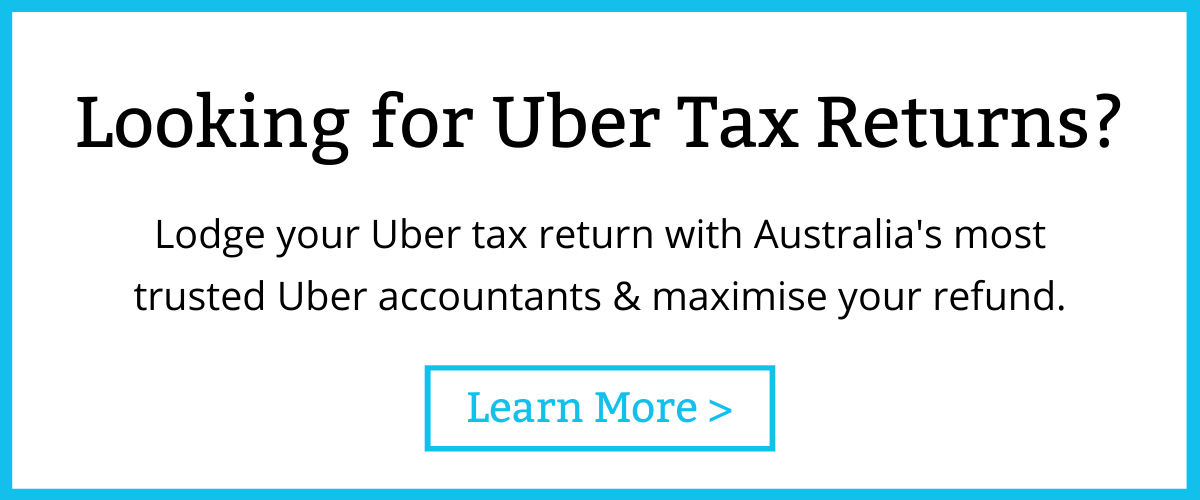
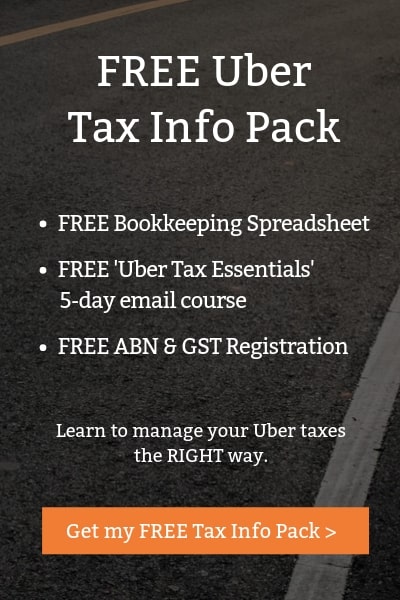
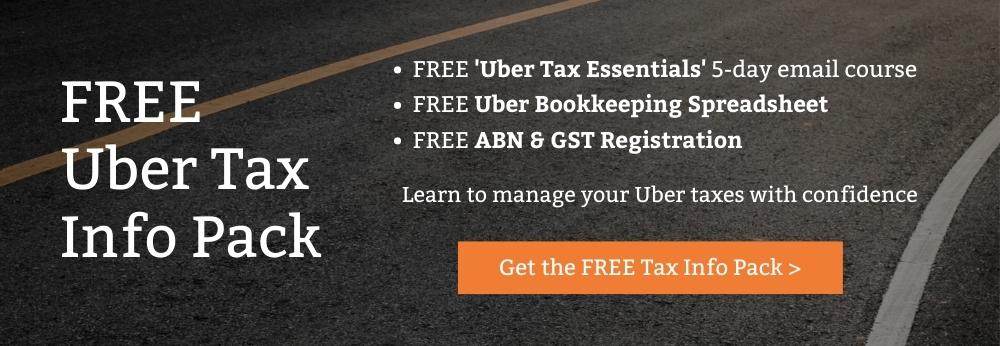
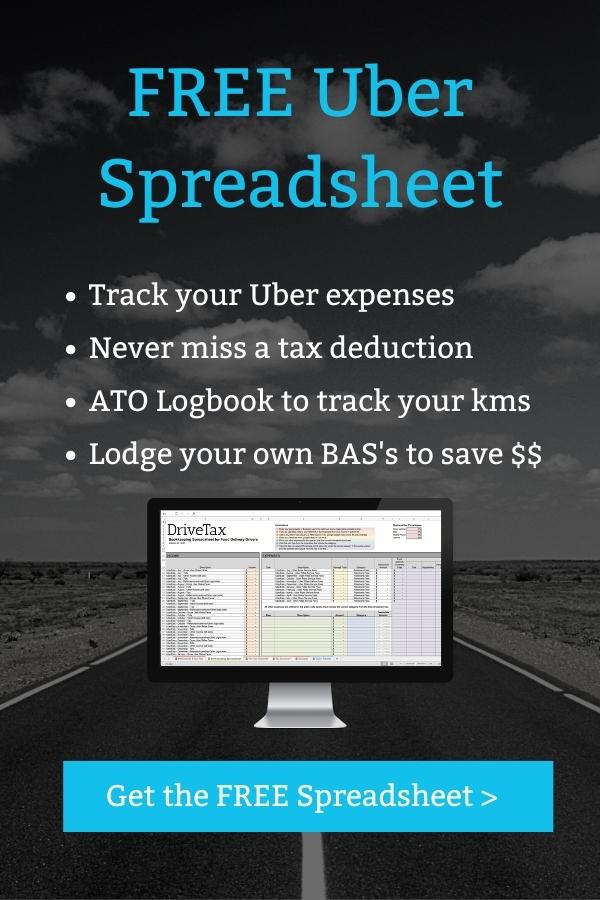
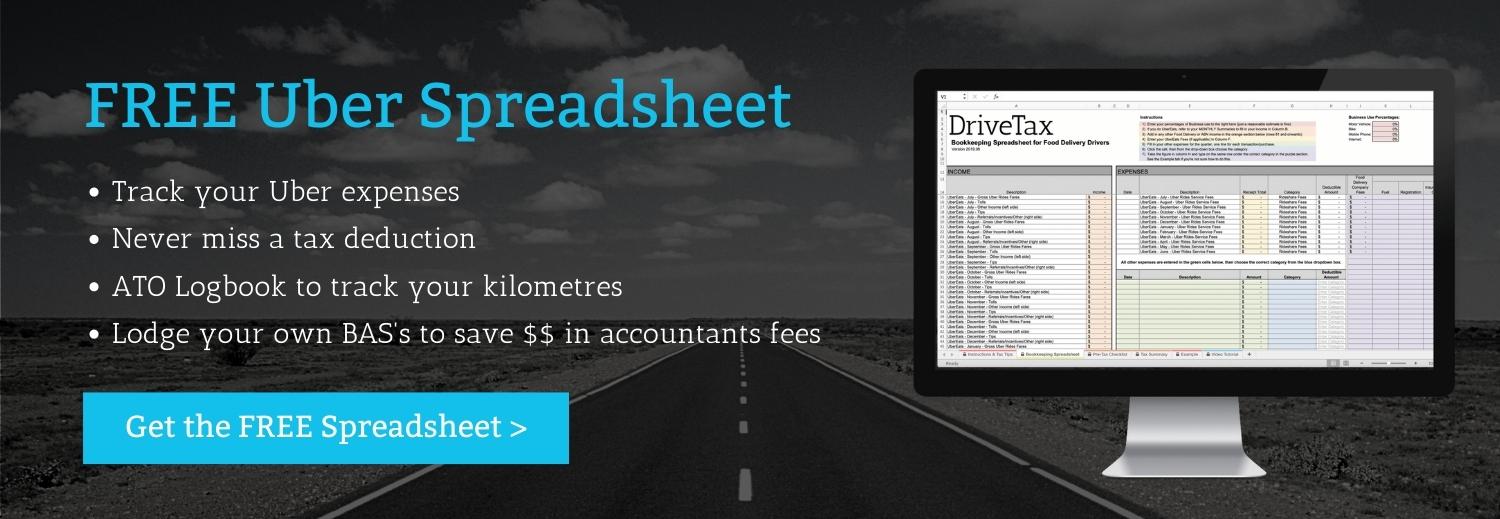
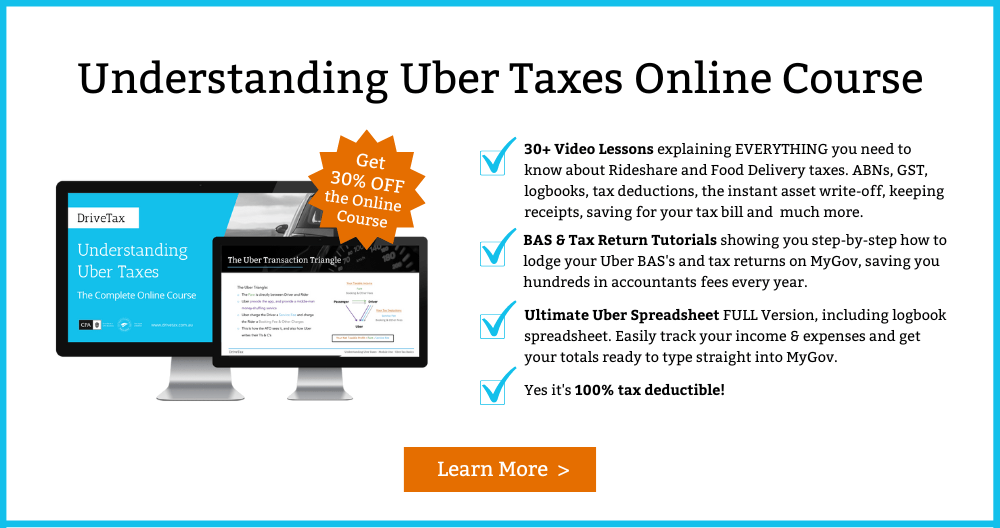
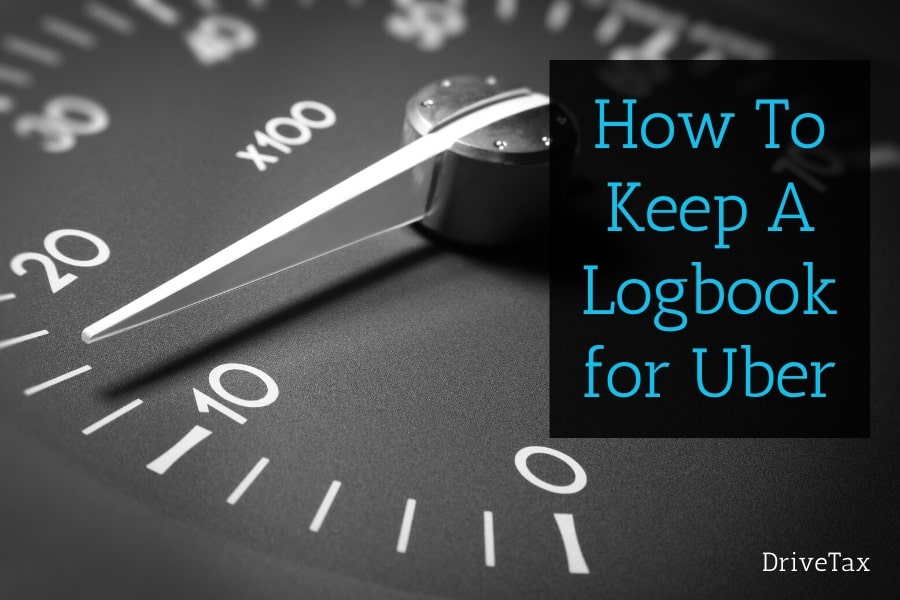
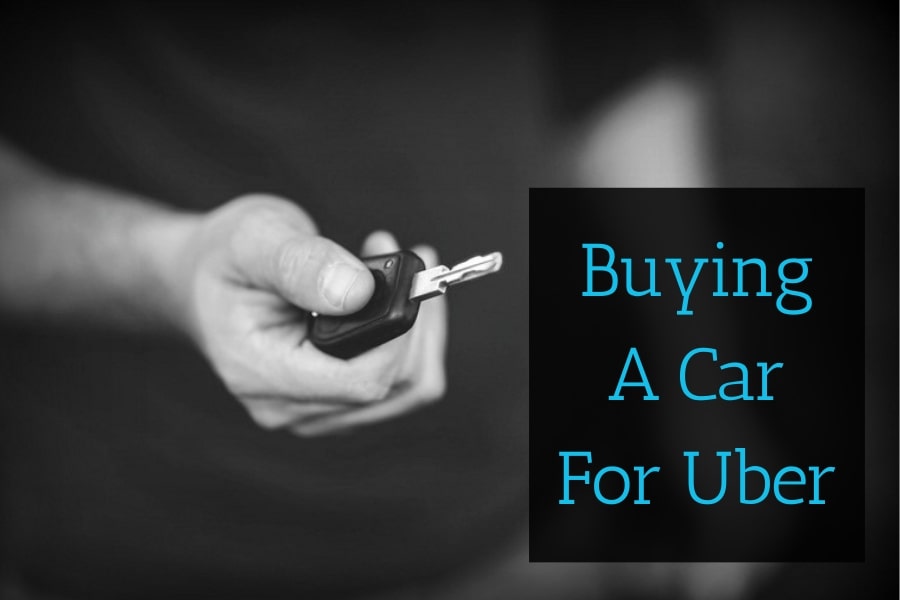
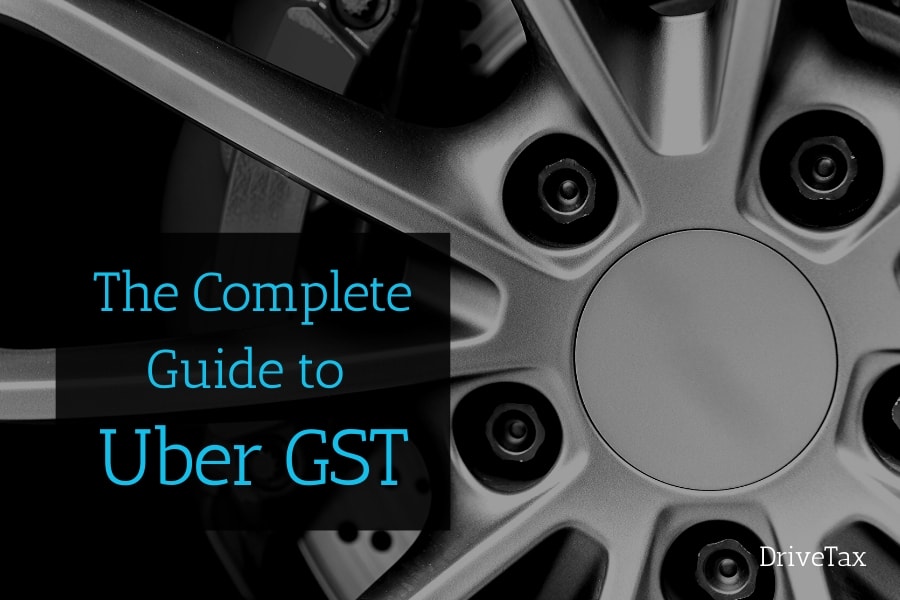
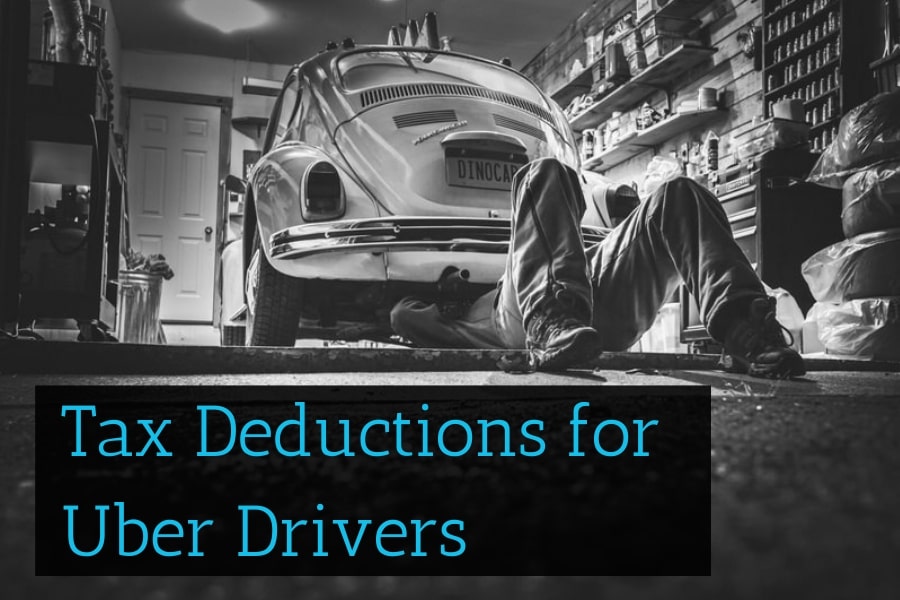
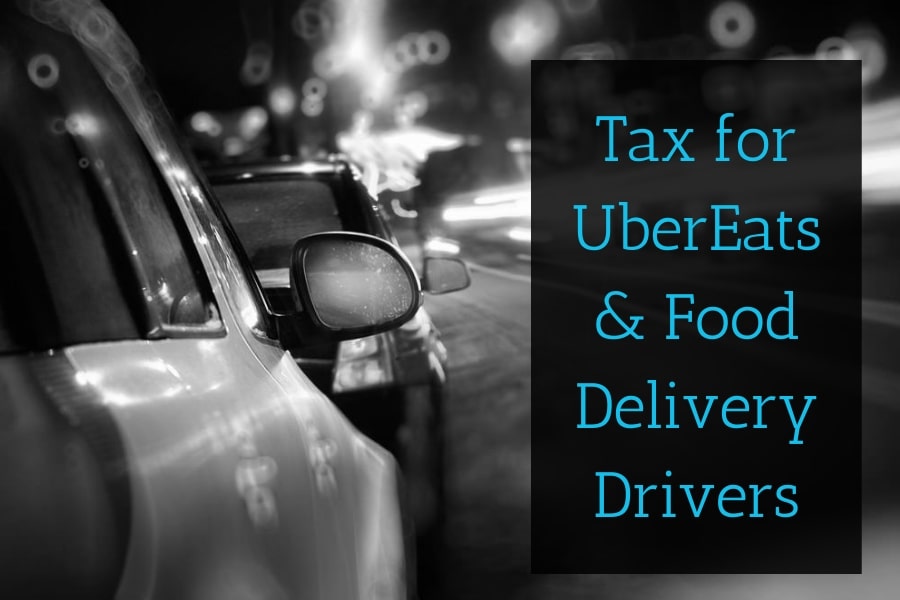
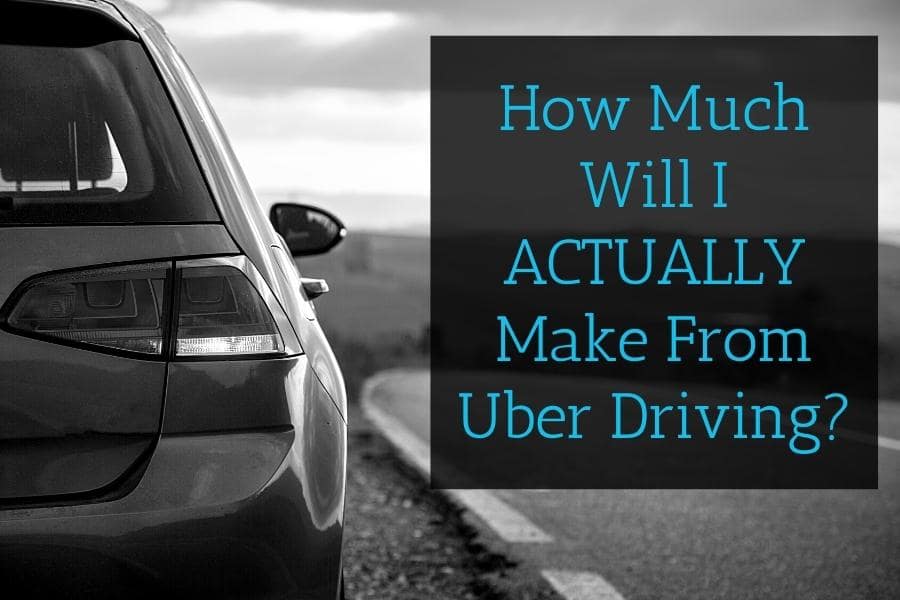
HI
I’m doing Ubereats on parttime basis and getting AUD 3000-4000 per month. Please advise whether I need to pay GST for this. when should i pay and how this calculated for my tax return
Hi Weerakkodige, this article above answers most of those questions, but I also recommend our article on Tax for Food Delivery Drivers. – Jess
Hi Jess, I wish I had read your article one year ago. Amazing how you explain everything in such detail. Thanks for that.
Could you please give me an advice?
I’ve been driving Uber for 14 months and never paid any GST or lodged BAS (just learned about it). I’m planning to lodge my tax return by myself soon, but I’m a bit lost what to do to get everything (tax/gst) sorted and not be considered illegal.
Can I lodge de tax return before fix the GST / BAS problem?
P.S. Uber is just an extra work which I do roughly 4-5 hours per week and I have my full time job.
Thanks
Hi Luciano, I’m glad this information has been helpful! My best advice is to focus on your BAS’s first, for two reasons. The first is that the ATO are more likely to apply late fines for your BAS’s because you have more of them overdue, whereas you only have one tax return. The other reason is that by collating your income and expenses for the BAS’s, you’ll already have the totals you need for your tax return. It’s much less work to do BAS’s first. I recommend our article Uber BAS’s Explained for more information on what you need to do. If you want to lodge the BAS’s yourself you may like to check out the DriveTax Ultimate Uber Spreadsheet that will do all the BAS calculations for you, or there’s our Express BAS lodgment service if you’d like them done for you. I hope this is helpful! – Jess
Question regarding combine income vs claimable expenses. Example, income is PA $90,000 (salary) + $5000 from casual ride share = $95,000 total income. Here is the question, if my uber / vehicle expenses exceeded $5000, call it $7500 (-$2500 net benefit), will that reduce my net total taxable income for both jobs from $95,000 to $87,500?
Hi Daniel. You’ve calculated your total income (business + employment) and then your expenses, but that’s not how the ATO does it. Instead, first they calculate your business income – business expenses = business profit or loss. If it’s a profit, it will always be added to your taxable income. If it’s a loss, then the treatment depends on whether or not you pass the non-commercial loss test, which for Uber drivers is usually the $20k income test. If you had more than $20k (pro rata) of business gross income then the loss is subtracted from your taxable income. Or, if you didn’t have $20k (pro rata) of gross business income then the loss is NOT subtracted, and instead it is ‘carried forward’ to future years. – Jess
Hi Jess, can you kindly help with below
– I wasn’t registered for gst from period Jul-Sept 2022 as I wasn’t required to and had Uber eats income for that period. I Registered from October. Now in annual Uber statement, will those 3 months earnings be included inclusive of gst or exclusive of gst?
Hi Awais, for Oct-June you only have to declare the GST-exclusive income, you don’t have to include the GST portion. So you will not be able to use the Uber Annual Tax Summary, you will have to use the monthly summaries so that you can add up your totals for July-Sept and Oct-June. – Jess
Hi Jess:)
If my annual income is under 18200 do I need to pay tax or upload income statements ? if so where should i do these?
Thanks
Hi Remio, if you earn more than $1 of income on an ABN you MUST lodge a tax return and declare all your business income, even if you’re under the tax-free threshold. If you’d like to lodge through DriveTax you can find the information about our Express Tax service here. – Jess
Hi Jes
Your information is very helpful. I just want to clarify the following question:
How much % should I put aside for tax and gst.?
Thanks
Hi Pav, allow me to direct you to this article on our website: Saving for your Tax & GST Bills. – Jess
Hi Jess,
How about uber careshare and how the tax apply. I believe quite similarly? (However there is no requirement to have an ABN).
and Is it advisable to work with an ABN at this instance so GST of (fuel and other can be utilised?)
Hi Jay, Uber Carshare, Car Next Door and other similar platforms, are not considered by the ATO to be businesses. Instead they are classed as passive income. This means they can not use your ABN, are not subject to GST, are not reported in your BAS’s, and appear in a separate section of your tax return. It also means you cannot claim the TFE write-off or small business depreciation, because the ATO does not consider the car to be a business assets. Instead you would claim traditional depreciation using the 25% diminishing value method. To claim car expenses you must still have a logbook, but you must label carshare kms separately from rideshare/delivery kms so that we can calculate two separate logbook percentages. I hope this is helpful! – Jess
I have received a sum of A$750 as a special UBER promotion in November 2022. I wonder whether this amount is inclusive GST or not. I believe since
this payment is promotional this does not include GST. Could you make a comment on this. Thanks
Hi Wilson, All payments you receive from Uber are subject to GST, including tips, bonuses and promotions. This is because they are connected to you providing a service (that’s the S in GST), for example completing a certain number of trips. . – Jess
Hi Jess,
I am currently trying to complete the Rideshare (business/sole trader) section of my tax return online via myGov. Splitting up the Uber tax summary figures into the available tax categories is a bit of a challenge.
Can I just put all the Income (fares, tolls, city & airport & booking fees, tips etc) into the section entitled: “other business income – manually calculated” and
Expenses (Uber service fee, tolls, city & airport & booking fees) into “other expenses – manually calculated” and put my car expenses and repairs into the corresponding “motor vehicle” and “repairs and maintenance” sections. Also put my car depreciation estimate into the “depreciation expenses – manually calculated” box, and I’m done?
Hi Steve, yes it’s no problem to combine all those income amounts in the Other Business Income section. For your Motor Vehicle Expenses ideally you should fill out the Motor Vehicle Expenses schedule where you would enter separate totals for each type of car expense (fuel, rego, insurance etc). You mentioned that your depreciation would be an estimate, note that this must be an exact calculation, whether by the Temporary Full Expensing write-off or by a diminishing value method calculation. And for all other car expenses, best practice is to itemise these as separate items in the Other Expenses category. Having said all of this, for the car expenses and the other business expenses it is possible to add them all together as one total, as long as you have documents to show your exact calculations in case the ATO should request to see them. – Jess
Hey Jess was just wondering if you could clear this up for me .
Lets say u earned 68,000 from uber and 20,000 in expenses so does that mean ur taxable income is 48,000 and you roughly have a 6,000 tax bill
Or
Do you have taxable income of 48,000 then u claim 21% of the 20,000 in expenses so u only have 2,000 tax bill.
Hope u undersrand what I mean lol.
Thanks
Hi Craig, your first example is roughly correct. Income – expenses = taxable income, and then you use the marginal tax rates (or this calculator) to work out the tax bill on that taxable income. – Jess
Hi Jess, You have handled the issue clearly, thank you so much that. Please Can I ask you a question? I have been doing uber eats for 3 months, I have registered Gst next to the Abn number, as far as I read, it is not necessary for those who do uber eats. Should I close my Gst record or is it okay if I don’t take any action even though my Gst record is active?
Hi Jasmin, if you are GST registered then you MUST pay GST of 1/11th of all of your ABN income to the ATO, including delivery income. So if you are not required to be registered (i.e. you are not doing rideshare) then I strongly recommend that you call the ATO and remove the GST registration asap, that way you won’t have to pay the tax anymore. You could try telling them that you registered by accident and ask if they can backdate the cancellation to the start so that you don’t have to pay any GST, but I don’t think they will allow it, so you will have to pay GST on the income you earned until now. But it’s worth asking just in case the allow it! – Jess
Thanks Jess. If I didn’t come across your website I would have just used my net income from Uber as my taxable income for my tax return. Not knowing any better.
Can I ask, when claiming the Uber service fee/tolls/city fee as an tax Deductible for the yearly tax return do I specify the amount excluding GST or including GST? And the Net income from Uber for the tax period, is this ex-GST?
Thanks in advance.
Hi Paul, I’m glad we’ve been helpful! All income and expenses in your tax return must be excluding GST. The GST on all your income and expenses will have already been dealt with through your BAS’s during the year. So on your end of year tax return it’s just the GST-exclusive portion that we have to declare. – Jess
Hello Jess,
Thank you for the clarification. In this case, shouldn’t the income tax calculation above exclude GST like so:
Income = Gross Uber Fares + Split Fare Fees + Tolls + City Fees + Airport Fees + Booking Fees + Tips
Expenses = Uber Service Fees + Split Fare Fees + Tolls + City Fees + Airport Fees + Booking Fees
Taxable Profit = Income – (Income/11) – Expenses – (Expenses/11)
Hi Tim, you’re exactly right, if you are GST-registered you would divide all figures by 1.1 (which is the same as subtracting 1/11th but a little easier on a calculator). I have just ignored GST in the example above to more clearly illustrate the relationship between all the elements on the summary. – Jess
Hi Jess,
I hope I do not double post my question here.
I have maintained a vehicle logbook. However, due to covid, I did not drive at all in the 2021 financial year. The only income will be jobkeeper payment. Just wondering, can I still use the logbook to claim for vehicle expenses like service and depreciation?
Hi Ubi, this is a subjective question. If a driver stopped driving just for the lockdown period and then started again when lockdown lifted and there was no outbreak then the original logbook would remain valid. This means it would be okay to still claim car ownership costs (rego, insurance, depreciation, car loan interest), but not usage costs (fuel, cleaning). However if they did not go back to driving at all in the financial year, even when the lockdowns and outbreaks were finished and it was possible to drive again, then I think the ATO would consider that they had stopped driving as a choice, so the logbook would become invalid and no ownership costs would be deductible. There is some grey area, and individuals might have particular circumstances, but this is probably the general rule that the ATO would follow. – Jess
Thanks for posting this article. Really appreciate the detailed breakdown of earnings and expenses.
Highly recommended if you want to understand the Uber tax statements.
Thanks for the kind words Steve! – Jess
Hi Jess,
I’m a newbie at uber driving and have just received my fist monthly statement.
I have to say i’m horrified at how complex this batch of information seems at first glance but am working through it religiously as i get that i need to understand it.
That being said, as uber invoice us for each payment period, i note that the invoice includes their horrendous fees PLUS the flat fee they charge for booking.
Can you confirm that we the driver pay this rider booking fee for each fare we take?
The reason I ask is because on the Driver App details provided for each fare we take, uber provide a heading, “Other Earnings” under which is listed the Booking Fee as both a deduction AND a payment with a net result of zero being deducted from the fare. They then appear to do a real sneaky thing by deducting this amount behind the scenes since it appears as a deduction in their invoices.
Can you clarify please?
Kind regards,
Hi Paul, the Booking Fee is paid by the passenger to Uber, it does not go to the driver. You collect this money from the passenger on Uber’s behalf and then pass it on to Uber. So from your perspective you will see it as both an income item at the top of the monthly summary (when you collect it from the passenger) and then as an expense in the Other Charges from Uber (when you pay it on to Uber). The same is true for Split Fare Fees as well. If you scroll up earlier in this blog post you will see the only income that actually lands in your pocket is the Gross Fares, Tips and Referral Fees, and the only expenses that actually comes out of your pocket is the Uber Fees. All the other expenses are covered by the passenger, so from your perspective they’re ‘money in money out’, they don’t actually cost you anything. I hope that explains it! – Jess
Hi, I’m want to know if your new ABN which you apply for today means you have to pay tax from when you started driving for Uber eats 3 years ago as you have to put a start date on the ABN form?
Thanks
Hi Michael, you have to pay the tax regardless of whether you got the ABN on the correct date or not. If you earn money in Australia you must pay tax on it. – Jess
Hi Jess,
I am filling in my details for ‘Business payment summaries’ in “Business/sole trader, partnership and trust income (including loss details)” heading and am wondering what the relevant payment type is for Ubereats deliveries.
Thanks,
Matt
Hi Matt, Business Payment Summaries is not correct, rideshare and food delivery income all below in Other Business Income. You must include ALL of your gross income including incentives and tips, but if you are registered for GST then you can exclude GST from your income figures. For a full step by step video tutorial on completing your tax return in MyGov check out our Understanding Uber Taxes online course. – Jess
I was wondering, as an international student who delivers for uber eats with TFN connected with my account. Can I lodge and claim tax return once a year?
Hi Siddhi, all the same rules apply for International Students, so you must have an ABN to do UberEats, and you must declare the income on your end of year tax return once a year. You can find more information in our Guide to UberEats Tax. I hope this is helpful! – Jess